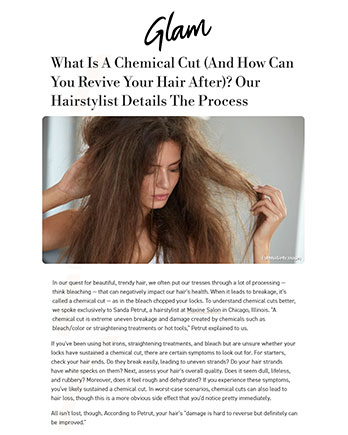Glam January 4, 2024
 Glam
Glam
Hair
What Is A Chemical Cut (And How Can You Revive Your Hair After)? Our Hairstylist Details The Process
In our quest for beautiful, trendy hair, we often put our tresses through a lot of processing — think bleaching — that can negatively impact our hair's health. When it leads to breakage, it's called a chemical cut — as in the bleach chopped your locks. To understand chemical cuts better, we spoke exclusively to Sanda Petrut, a hairstylist at Maxine Salon in Chicago, Illinois. "A chemical cut is extreme uneven breakage and damage created by chemicals such as bleach/color or straightening treatments or hot tools," Petrut explained to us.
If you've been using hot irons, straightening treatments, and bleach but are unsure whether your locks have sustained a chemical cut, there are certain symptoms to look out for. For starters, check your hair ends. Do they break easily, leading to uneven strands? Do your hair strands have white specks on them? Next, assess your hair's overall quality. Does it seem dull, lifeless, and rubbery? Moreover, does it feel rough and dehydrated? If you experience these symptoms, you've likely sustained a chemical cut. In worst-case scenarios, chemical cuts can also lead to hair loss, though this is a more obvious side effect that you'd notice pretty immediately.
All isn't lost, though. According to Petrut, your hair's "damage is hard to reverse but definitely can be improved."
How to revive your hair after a chemical cut
Speaking exclusively to Glam, Sanda Petrut provided helpful tips on how to reverse hair damage caused by chemical cuts. "Consult with a professional to come up with the best-customized plan for reviving the hair," she told us, starting with cutting off the damaged ends. Talk to your hairstylist to decide which haircut would "work best under the circumstances." You may have to go a little outside your comfort zone to hide any traces of your chemical cut, but it'll be worth it.
Once your damaged ends have been removed, you must establish "a routine by using a strengthening shampoo and conditioner, followed by a leave-in mask once or twice a week," per Petrut. Moisturizing the hair is key, so you might also want to consider oil masks using avocado oil for soft and smooth hair. "Kerastase's Resistance Bain Force Architecte Shampoo and conditioner ... would rebuild and strengthen damaged hair fiber and would prevent further damage," Petrut explained to us. The product's key ingredients include pro-keratin complex, which is "a blend of protein and amino acids"; ceramides, which "promote elasticity [and] moisture retention and aid in strengthening hair"; and myrothamnus flabellifolius, which helps bring life back to the hair strands.
For extremely damaged hair, Petrut suggested the Kerastase Resistance Bain Therapiste shampoo, conditioner, and serum. This product "repairs and has thermo protection with key ingredients such as gluco peptide that penetrates to the deepest layer of the cuticle to strengthen and stimulate hair growth" as well as "wheat protein derivative" and "native plant cells" for deep hydration, according to Petrut.
Tips to prevent hair breakage
The best way to avoid getting a chemical cut is to steer clear of harsh chemical procedures, avoid over-processing the hair, and not overlap your treatments, as Sanda Petrut exclusively told Glam. Even simple keratin treatments can go wrong, so being extra careful with how you treat, bleach, and straighten your hair is crucial. Additionally, she suggested protecting your hair with a "sulfate-free shampoo that detoxifies hair after any color service and contains a patented technology concentrated with glicoamine, a molecule small enough to penetrate and neutralize metal inside the hair fiber." Here, Petrut named L'Oréal Professional Metal Detox.
If you want to kick it up a notch and protect your beautiful tresses with more than just home treatments, Petrut suggested trying the three-step Olaplex treatment. Done in a professional hair salon, this treatment "guarantees your color of lightening services for 87% less breakage and 100% reliable color results" while working at a molecular level to protect all hair types.
Other simple things you can do to protect your strands include choosing the right brush for your hair type, doing looser ponytails, and opting for a microfibre (instead of cotton) towel to dry your hair instead of blow-drying. As a last precautionary step, ditch your cotton pillowcases and invest in silk ones that decrease friction while you move in your sleep, minimizing unwanted breakage.
